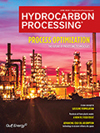A multi-objective optimization study for an integrated oil refinery-petrochemical plant—Part 1
The study of the ideal integration of an oil refinery and an ethylene production facility has regained interest due to the rising costs of crude oil and its derivatives. This study proposes a multi-objective optimization approach that maximizes the net profit and production of ethylene and propylene in an integrated plant.
IP: 3.138.68.161
The Authors
Al Anazi, K. Q. - University of Bahrain, Department of Engineering Management, Isa Town, Bahrain
K. Q. Al Anazi, University of Bahrain, Department of Engineering Management, Isa Town, Bahrain.
Shams, M.B. - University of Bahrain, Department of Engineering Management, Isa Town, Bahrain
M.B. Shams, University of Bahrain, Department of Engineering Management, Isa Town, Bahrain.
Al Masri, H. - University of Bahrain, Department of Engineering Management, Isa Town, Bahrain
H. Al Masri, University of Bahrain, Department of Engineering Management, Isa Town, Bahrain.
Related Articles
From the Archive






Comments